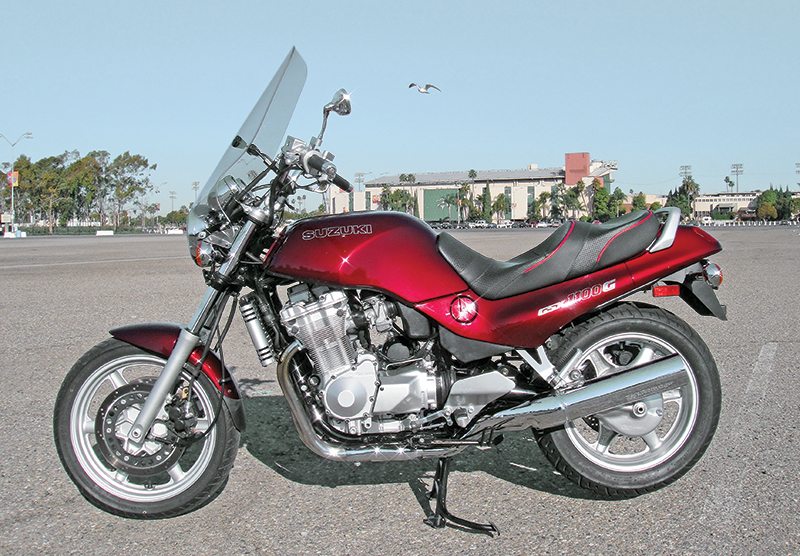
It was big at 1,100cc, good for 130-plus mph, and comfortable. You could spend all day on this bike, easily racking up a few hundred miles. And it was cheap—or at least relatively so at $6,000 in 1991 dollars.
But who was the intended buyer for this Gixx-Gee? Not the sport rider, who would opt for the GSX-R1100 gixxer. Nor the cruiser minded, who were probably looking at Intruder models. Touring types? Maybe, but that would require a bit of dressing. An all-rounder? That’s it! A UJM updated a few years from Suzuki’s last big all-rounder, the 1983 GS1100G.
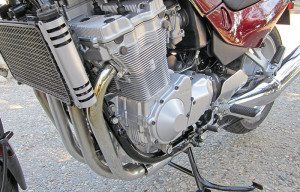
But this was the age of specialization—with the exception of a few mid-size standards. What was Suzuki doing with a big UJM? Therein lies a tale of bean counters and perhaps a touch of desperation. And the American market’s lust for more power.
Back in the late 1980s, the motorcycle companies were coping with lousy sales and were wondering how to create new product without spending too much money. R&D cost a lot, and building entirely new engines and chassis involved time and lots more money. The engineers appealed to the suits by handing in some pretty drawings of a motorcycle that used an already proven engine, from the GSX-R1100, tucked into an old-fashioned tubular frame that would not cost much to build. Add some conventional sheet metal, put on a long saddle…bingo!
There was background for this notion. At the request of American Suzuki, the factory had made secondary use of the Intruder 750 V-twin drivetrain by taking it out of the cruiser chassis and putting it in a “standard” frame, resulting in the very pleasant VX800. To improve handling, the steering rake was pulled back from a lazy 36 degrees to 31 degrees, and the driveshaft was lengthened to help reduce the jacking effect common to most shaft drives of the era. And the VX price? A rock bottom $4,600 when it appeared.
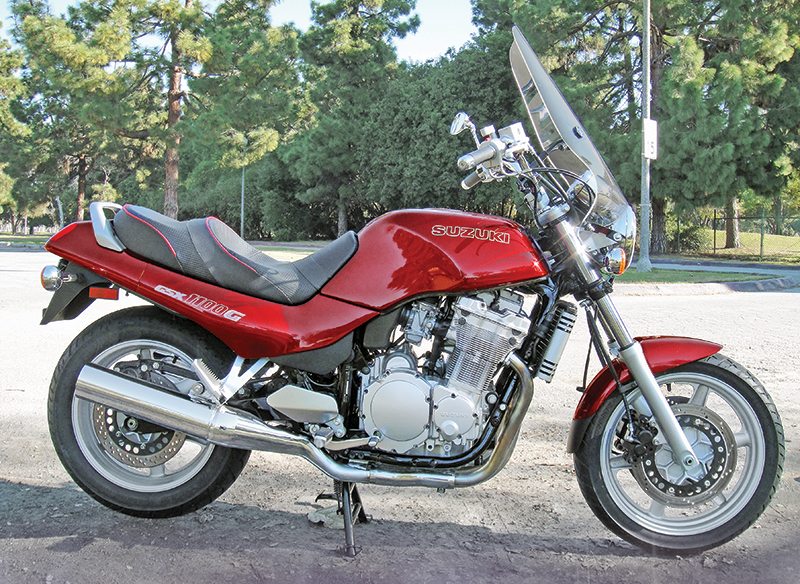
Those boys at Hamamatsu (Suzuki’s headquarters in Japan) had been building solid, shaft-driven UJM all-rounders since the GS850G of 1980, ending temporarily with the aforementioned GS1100G. The G after the number was Suzuki’s way of indicating shaft-drive on one of those in-line fours, all of which had begun with chain drive. These were all big, fast and comfortable—the last of a series of 8-valve engines that had begun on the GS750 back in 1977.
After 1985, the company focused its larger models on sportbikes and cruisers, and the uninspired Cavalcade touring bike in 1986, which languished and disappeared after four short years. A lot of money was spent on that failure, a ground-up creation, with the suits blaming the Americans for having misread the market.
The most successful engine was that powering the GSX-R1100. In 1989, the in-line 4 was distinctly oversquare in design with a 78mm bore and 69mm stroke, for a total of 1,127cc, putting out 108 rear-wheel horses at 9,500 rpm. It had air- and oil-cooling, two overhead camshafts, four valves per cylinder and blessed threaded valve adjusters, much loved by home mechanics. With a few mods this version could be turned into a tractable everyday motor.
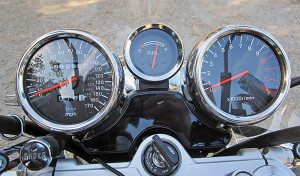
First mod was major, inserting a counterbalancing shaft to keep those pesky vibrations away from the highway rider. Just to make sure there would be no complaints, the engine also had elastic motor mounts. Second mod was the camshafts, redesigned to give more low- and midrange power, with the overall result being that the dyno showed about 10 percent fewer ponies in the herd, 98 at 7,500 rpm. Not that this mattered much, as the bike could still reach 140 mph…on a straight, smooth road please, as it was not into knee-down cornering. The 5-speed gearbox was OK, but the engineers grafted on the shaft drive from the Cavalcade.
The GSX-G had an entirely new chassis. From an aluminum perimeter frame, the new model went to a steel, tube-type full cradle. The GSX-R had a wheelbase of 56.7 inches, with a front fork raked out a modest 24.6 degrees; trail, 3.9 inches. The GSX-G, on the other hand, had almost six inches more wheelbase (62.2 inches), and a quasi-cruiseresque 33 degrees of rake, with 6.1 inches of trail. This was going to be a heavy, slow steerer, but really comfortable and stable on the straights. The Gixxer had 17-inch wheels on both ends, the Gixx-Gee, a 17 on the back, an 18 on the front carrying a relatively skinny 3.00 tire.
The GSX-R also had a fully adjustable suspension fore and aft, and while the GSX-G had a fully adjustable shock, the front end had no adjustments. The two front discs on the R had four-piston calipers, while the G’s disc used only two-piston squeezers. All this added up in weight—with the G’s 615 wet pounds being almost a hundred pounds more than the R’s 530. But cost, the real key, was at $5,999, almost 20 percent less than the R’s $7,300.
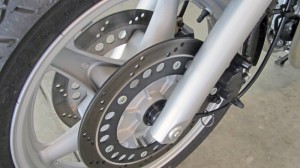
And it was 100-percent more comfortable. That was a great selling point—good saddle, good seating position, and if you didn’t like the handlebars (they were a bit tall) a new set could easily be bolted on. A 5.3-gallon tank meant that you had close to a 200-mile range. Curiously, the tank had an electric pump, since the bottom of the tank was under the carburetors. And a recommendation that the petcock be turned to OFF when parked—shades of the old Brit bikes. A fuel gauge between the instruments did give an approximation of where the fuel level was, but old reliable was the RES position on the petcock.
Many riders saw the GSX1100G as a under-equipped touring bike, though the ads did state, “An optional fairing, windscreen and saddlebags are available as perfect sport-touring complements.”
The price was good, the bike was good—the economy was in the dumps. From over 700,000 new motorcycles sold in the U.S. in 1985, less than 300,000 were sold in ’91, ’92 and ’93. It was a bad time. At the end of ’93, Suzuki decided to cut the GSX1100G as well as the VX800. The price of the G had crept up to $6,500, while the ’93 GSX-R, with a new liquid-cooled engine and revised frame, cost a hefty $8,200—and was selling in reasonable quantities.
Maybe the moral of that story is that the Everyman motorcyclist looks to essentials when times get tough, while the Gottahave Rider will pawn his wedding ring to buy what he must have.
(This Retrospective article was published in the December 2013 issue of Rider magazine.)

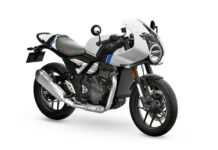

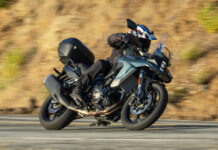


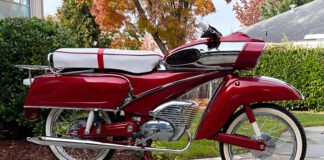

I picked up a GSX-1100G with 25000 miles on it for $1200 on eBay two years ago. It’s got a great motor and is very low maintenance. My last bike was a ZRX1200 and i prefer the GSX.
Greetings from Germany Dortmund
I have also a ZRX 1200. and I am interested to buy a GSX 1100G.
Can you tell me more ?
NOSTALGIA!
Back in 1991 I bought a GSX1100G from a dealership in Redondo Beach, Ca. Later on I sold it to a dealership in Ventura. My bike had the same Corbin seat as this one (made at Corbin’s on a Saturday morning in Castroville). Also, it had exactly the same scratches on the side of the tail piece. The fairing had a red tint and a rubber buffeting deflector on it. I had the dealer install GSXR cams on it as well re-jet it to GSXR’s specs. It was a wheelie machine. I rode it all over the US. Could this be my old bike? Gee, that was the best bike I have had in my life!
No sorry, this bike was purchased out of New Jersey.
Elmer NJ by anychance? I sold one low mileage about 1997 miss that bike a guy came to look at it and the mechanic he brought with him bought it
Granted, it’s wonderful,–I’d LIKE one myself, but as long as the developement money was already spent, WHY not put the water-cooled engine from the “R” into the “G”, and turn it out like the Yamaha FJs. If a shaft wouldn’t “work”, than use a belt rear-drive,–oh, and don’t forget the Hydraulic-valves that are on even lowly Royal Enfields, and put them on the “G” head WITH those “R” cams. Also, carbon-fibre the plastic, use more aluminum, and DROP 100 lbs off of the “G”
In 1993 bought this one’s sister the 1993 GSX1100F Katana, I still have it, but can’t find anyone who I can trust to sort the carbs out. I live it Medina Ohio if someone knows a reliable Suzuki mechanic.
George,
I have just finished the carbs on my 93 1100 G. I bought the bike a month ago with 2000 miles on it. The original owner had parked it full of gas in 1994 and never touched it again. Long story short, if you have questions about the Mikuni BST 36 SS carbs on your bike I can answer them. In all seriousness I know more about them than any mechanic you will find.
E mail me chuckbranham21@gmail.com.
I live in KY
Chuck, I just noticed your message Feb 2021, I would like some info about carbs. what is happening with my gsx1100f Katana is that it seems to leak into the cylinders. pe t cock looks ok. I will explain more later. I am in Medina ,Ohio. I did have a work shop manual and it has Mikuni34s not 36s like the G model
I’m in Dayton Ohio and I done my syncing and adjusting myself. YouTube tutorial and all. Lol
I owned the best “G” ever!
Not boasting, check it out (pics at link)
http://advrider.com/index.php?threads/the-best-gsx1100g-ever-on-the-road-one-of-a-kind.1028486/
Bought my 1100g in 92,and after 100.000 miles,still running great. Have a spare bike for parts,if something should happen. The repairs has been minor,think the shaft was most expensive repair in 96,after change and lubricating it,wich it isn’t from factory,no more problems.
Where can I find the front reflectors for my 1993 GSX1100G g?
I WANT TO BUY A GSX 1100G 1993
I have a 92 model I would sell, if you’re interested in it.
I have the 93 . New everything.
I have a 93 GSX1100G if you’re interested.
Bobby;
I have a freshened up ’92 ready to go anywhere. 95% mechanical, 90% appearance, 23,000 miles, Seriously it’s in near showroom condition…
It’s just too much for my old broken up body to handle these days.
Text me @ 318.355.2859 and we’ll go from there.
Located in 71291.
hello I have a 1993 suzuki 700 r gsx 721 miles original run good new brakes change oil clean carburetor system for sale R perry 310 977-5008
I’m buying a very nice 1992 Suzuki GSX1100G with only 15K miles. Never rode one but but am familiar with the package. Thought I’d try it…and if I don’t love it…will just sell it. Typically ride big bore sport and sport-touring type bikes. Owned a number of big bore Suzukis…had a Bandit 1200 and a Bandit 1250…also ran a Suzuki franchise from 1977 to 1984 and rode many of the GS series bikes. From what I read on these GSX1100G series bikes…they’re a great UJM type bike. We’ll see!
I bought my GSX 1100G brand new in Kennewick, Washington…and it’s still goin’ today. Had the carb’s cleaned back in 2007…That’s about it apart from a couple cables. I removed the trim and the tank; fenders are primer coated. It looks like something right out of the road warrior. I took it out on the Patterson flats (above Prosser, WA) and accelerated to 135 mph. I was a long way from redline, but without faring, it felt as though I would blow away if I hit the slightest bump. It’s still a beast. Couldn’t be more different from my VSTROM 1000.
Imagine a large bike that leans over quite well through the turns but can grunt through those same turns from 2000 rpm’s on up!! Then add a seat that will go an easy 125 miles before a little walk around and hydration (my ritual) is necessary. Large bikes can do things smaller bikes cannot do. And that is carrying capacity! Two up with baggage is almost an after thought. This thing is a 1st, 3rd,5th gear shifting bike if one desires!! IT’S A TORQUE MONSTER!! No downshifting necessary to pass!! Have had mine since 07 and it uses tires (Shinko – anyone getting over 7500 miles on a rear tire?) and have changed front fork springs to Sonic straight rates. What a difference!! You should go to the Sonic Suspension website and read the tech link paragraph explaining straight rate springs vs. progressively wound springs. Made perfect sense to this rider and seems to be a perfect for the girth of this bike!! A little hard to move at less than 3 mph in park lot ( long wheel base) but is gone once the bike starts to move around!! If you are looking for a Japanese shaft drive 1100, this is the best ever to come out of Japan!! Have had XS11’s ( loved them) and KZ1100 and thought that was nice , too. (ergo’s seemed a bit compressed) but overall the GSX1100G is the most refined 1100 shaftie four banger (please – no V-Twins in this displacement) ever to come from the Land of the Rising Sun!! Take one down the road 50 miles and you’ll know. One more thing, A SlipStreamer Spirit fairing is a very nice touch to create full fairing (almost) comfort and protection for the rider/passenger. 80mph is it’s sweet spot!! And lastly….IT DOESN’T BREAK!!! EATS TIRES AND GAS……THAT;S ABOUT IT………………..
I’ve only just come across this review as a result of a chat with a guy with an 1100G at the same time as working on a 1100F ‘Power Screen’ for a friend.
A particularly interesting part for me was the surprise at seeing the paragraph about the drop in bike sales in the early 90s. It’s a surprise (speaking as a Suzuki guy, in England) because whatever slump there may have been – and whatever models the company dropped during those years – it also seemed a period when Suzuki was still creating *new* models, as if to fill any gaps in the market that it could find, particularly in the middleweight class. A gap between the GSX600 and the GSX-R? Let’s make a budget sports model – the RF – to fit between them. One DR650 not enough? How about making it into two different versions? And how about a V-twin [the SV] and a road bike with a bit more ‘attitude’ than the average commuter bike [the Bandit]. Paradoxically, at least from a European viewpoint, Suzuki never seemed more prolific than in the years 92-97
Buying a 1993 Suzuki GSX 1100E tomorrow 14,000 original miles only 3K I can’t wait My head will be spinning and so will the tires lol next spring planning a trip to the east coast cuz that’s what these bikes are made to do. Cruise.
I’m confused; I had a GSX 1100 G. I was told it was modified by some bike shop owner, but I do not know how… It would do a 9.2 in a quarter mile and at the end of third gear I was going 170 mph. How the heck was it modified to do this? I never went faster than that because of the vibrations developed. I still had three ( I thought all the Gsx-g’s had 6 gears, lol) gears left but I did not dare use them past 170… it seems like the top speed would go well over 200mph and this was a ’92 bike I think (the year of the bike didnt mean much to me). I remember the top gear kinda would make it seem like it was idling at highway speeds.
Only made three years. They were not big sellers and tons of them sat in corners of showrooms. My buddy had a 91. I ended up with the same color 93 that I bought new in 95 after looking for a year. I knew some shops that had one or two, but by the time I got hot on it the supply was drying up. My dealer got a line on one and imported it from out of state for me. They thought I was nuts. Put the Corbin set on it with the slide in back rest for passenger. They big was big, comfortable and definitely ate up the miles. 75 always felt like 55 and leisurely. The magazines described this bike as a couch on wheels. Suspension had a Cadillac feel to it yet not at all sloppy. To the uninformed the bike was quite mild mannered for that big Gix sitting down there, quiet and smooth. My hot rodding days had long passed so I drove it sort of like a Sunday School teacher, an old one. Every now and then you just needed to create some space out there on the road with the morons and turning up the gas hitting 4,000 rpm, that bike turned into a regular Dr Jekyl. Climbing, above 4,000 it would be like a growling wildcat after its first meal in over a week. Was a very good feeling knowing the bike could do that. Wasn’t much in the turns except steady and predictable. Just don’t step out of the box too much, you will know it. Funny I was looking for GSX1100G stuff to read just now to see if they weren’t completely forgotten about when I found this. Wifey and I were talking about that bike this morning and how much we loved it. Riding a Harley Ultra now. Except for the bags, and seat, if Suzuki made that same bike right now today in 2025, I would sell the Harley today and buy one. No Bandits or KZ retro stuff with a chain, though beautiful. I’d buy that G with the mini apes and all right now. Boy that bike could do just about everything, and fun. That is what it is all about right. The fun.